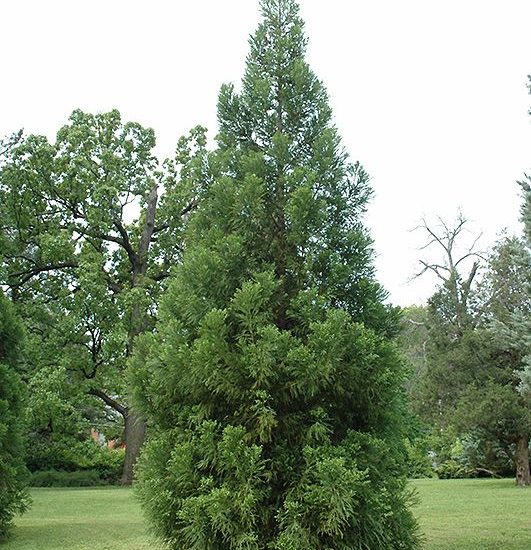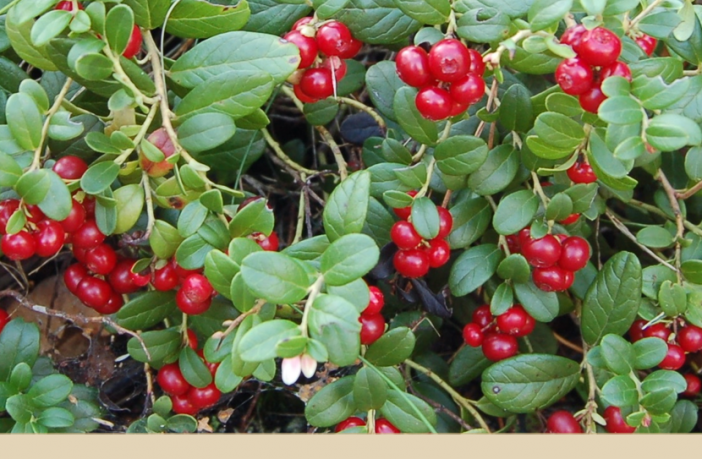Arborvitae Trees: Plant, Grow and Care
In this article, we will examine the questions like; what kills arborvitae trees, how to save brown arborvitae trees, how to plant arborvitae trees and arborvitae trees for sale, etc. There are many things to learn about arborvitae trees, so let’s start!
It’s critical to do your research while selecting trees for small gardens. You should find out the tree’s ultimate height and how long it takes for it to reach that height. Some species are slow-growing, and while they may fit well in a short yard at first, they will quickly outgrow it, blocking light and may be causing harm to your home’s foundations.
Fortunately, several tree types and varieties have a compact growth habit and will not outgrow their environment. A well-placed, well-chosen tree will serve as a lovely point of focus and provide diversity throughout the year. There are many suitable trees for pots if you simply have a terrace or balcony.
How to Choose the Best Tree for a Small Garden
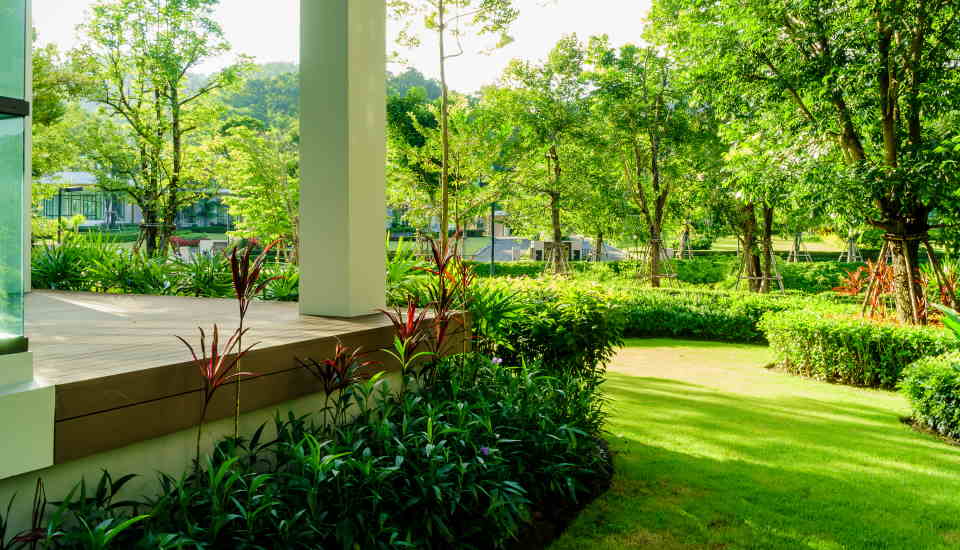
In the spring and summer, trees can provide beautiful garden flowers. In the fall, they will mesmerize with their vibrant leaf color, and in the winter, they will have fascinating bark and roots.
In balcony gardens and residences near a busy road, the best trees for a tiny garden can also serve many purposes, such as concealing an unappealing view or filtering noise and air pollution.
Don’t worry about your tree becoming too big: many are ideal for even the smallest of places, and most trees can be pruned regularly to keep them small.
Types of Garden Trees
The most difficult thing is choosing the best type of garden tree for your taste and your garden. Now we will try to help you to choose the best tree for your garden. There are many types of garden trees on the earth. Let’s check some of them; you can easily find a tree for your taste.

Vitex agnus-castus (chaste tree): This incredibly quick tree grows lavender blossoms with a characteristic sage scent. Chaste trees flourish in various soil types and grow best in warmer areas.
Cherry plum (Prunus cerasifera): The cherry plum tree is known for its red or purple leaves and white or pink blossoms. It is native to southern Europe and Asia.
Crabapple tree (Malus): Crabapple tree produces large blooms of white and pink flowers, as well as red fruits, known as crabapples, which attract birds and other important pollinators.
Crape myrtle tree (Lagerstroemia): These deciduous trees and bushes are endemic to the Eastern United States and have a dense growth habit. Summer flowers on crape myrtle trees are white, pink, or red, and the foliage turns crimson and orange in the fall.
The Dogwood tree (Cornus Florida): The Dogwood tree is a well-known flowering tree with white or pink blossoms and a pyramidal growth pattern. A popular cultivar, Kousa dogwood, has star-shaped blossoms and grows hardy in cold climes.
Fringe tree (Chionanthus): These trees produce white, fragrant blooms with fruit and vegetables. The fringe tree has a rounded shape and is resistant to fire, thanks to its foliage.
Acer palmatum (Japanese maple tree): Japanese maple trees are known for their spectacular, deep crimson and purple leaves and bonsai shape.
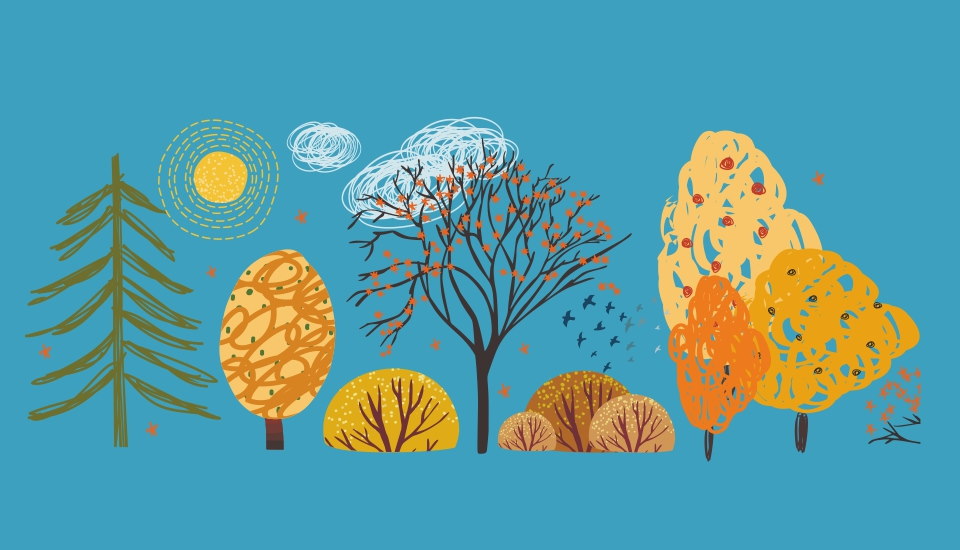
Syringa reticulata (Japanese tree lilac): The Japanese tree lilac (Syringa reticulata) is a deciduous tree with creamy white flowers and green leaves that bears brown fruits.
Magnolia trees (Magnoliaceae): Magnolia trees contain fragrant flowers and waxy or shiny leaves. Many variations, such as the star magnolia with purple blossoms or the sweet bay magnolia evergreen tree with large white flowers, come in various flower colors and leaf styles.
Hydrangea paniculata (Japanese Hanakotoba): Hydrangea paniculata has little pinkish flowers that change color according to the season. This tree can thrive in full sun or shade and has a constant annual bloom.
This dwarf version of the serviceberry tree (Amelanchier): Is drought-tolerant and low-maintenance, making it one of the best trees to plant in a small location. The tree blooms with white flowers from late spring until late summer and produces tasty berries.
The ‘Winter King’ green hawthorn (Crataegus Viridis): It is a popular deciduous tree with a wide spread of green foliage. Because of its disease resistance, the ‘Winter King’ is one of the best trees to grow.
What Are The Types of Arborvitae Trees
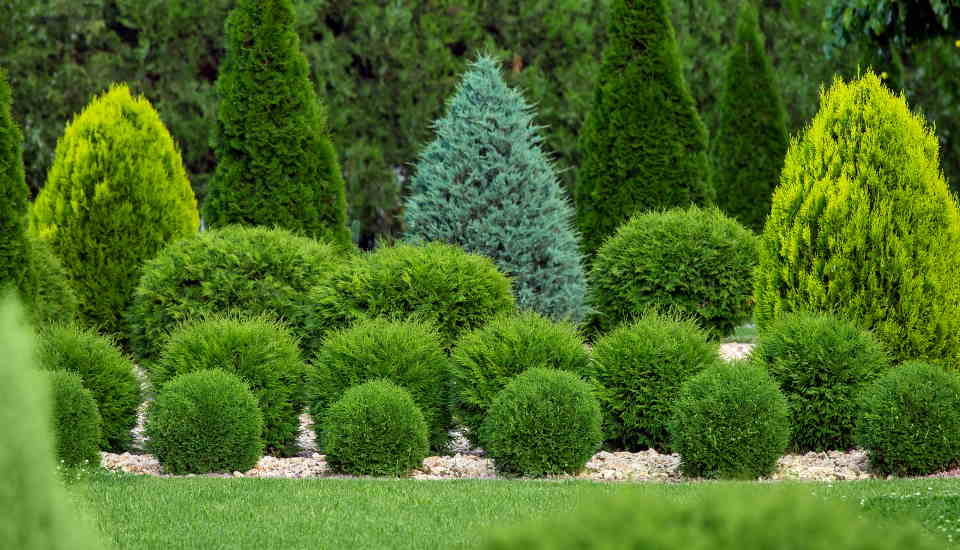
What is the arborvitae? Arborvitaes are trees or shrubs with thin, scaling outer and fibrous inner bark, horizontal or ascending branches, and characteristically flattened spray-like branchlet systems. They have thin, scaling outer bark and fibrous inner bark, horizontal or ascending branches, and characteristically flattened spray-like branchlet systems.
There are four rows of small, scale-like leaves on each branchlet. Juvenile leaves are significantly longer and needle-like and may persist alongside mature foliage in some species.
There are different types of arborvitae trees, and we will try to explain every type of arborvitae tree to you. Some types of arborvitae trees are globe-shaped. Arborvitae trees can be found in a variety of shapes, including globes. Mounded, conical, pyramidal, rounded, and pendulous are some of the other shapes. The needles of most cultivars are medium to dark green, while some are yellow or even golden. We are going to analyze two types of arborvitae trees.
Globe-Shaped Types of Arborvitae Trees
- Danica is an emerald green globe flower with a height and width of 1-2 feet (31-61 cm).
- Globosa — medium green growth with a spread of 4-5 feet (1-1.5 m).
- Golden Globe – a plant with a golden leaf that reaches a height and width of 3-4 feet (1 m.).
- Little Giant — medium green with a 4-6 feet height and spread (1-2 m.)
- Woodward is a medium green flower that grows to a height and width of 4-6 feet (1-2 meters).
Pyramidal Arborvitae Trees Varieties
- Lutea, also known as George Peabody, is a golden yellow narrow pyramidal form with a height of 25-30 feet (8-9 meters) and a width of 8-10 feet (2-3 meters).
- Holmstrup is a dark green, slender pyramidal plant that grows to 6-8 feet (2 meters) in height and 2-3 feet in width (61-91 cm.)
- Brandon is a dark green, pyramidal plant with a narrow shape. 5-6 feet (1.5-2 m.) wide and 12-15 feet (4-4.5 m.) high
- Sunkist is a golden yellow pyramidal plant that grows 10-12 feet (3-4 meters) tall and 4-6 feet (1-2 meters) broad.
- Wareana is a dark green, pyramidal plant that grows 8-10 feet (2-3 meters) tall and 4-6 feet (1-2 meters) wide.
The Best Trees for Front Gardens
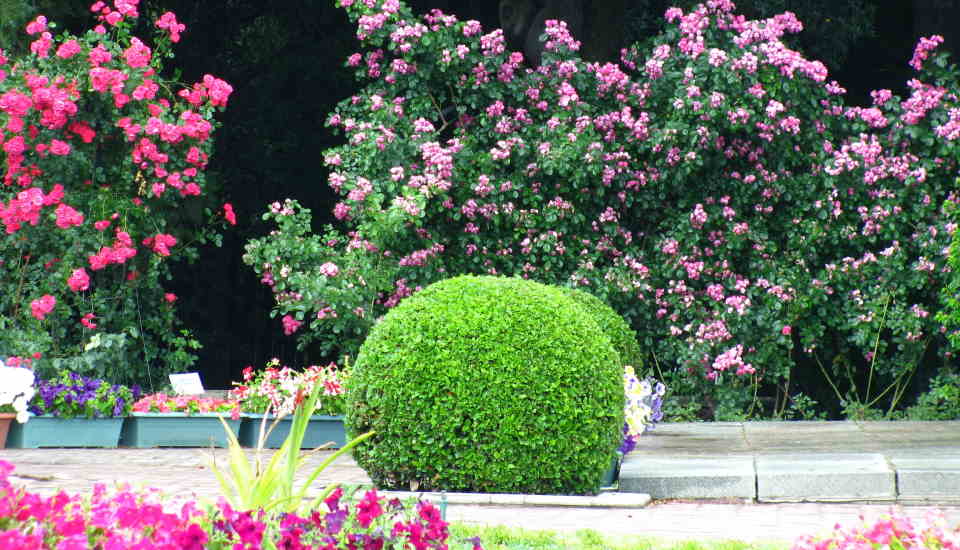
You may dramatically modify your front garden tree design by selecting the best trees. Choosing a tree that can thrive in a tiny space while also adding year-round interest to your front garden landscape is crucial.
It’s crucial to figure out what you want from a tree before selecting one for your front garden. It’s also important to consider the circumstances of your front garden, such as the type of soil, whether it’s north-facing or south-facing, and whether you have harsh summers and/or winters. All these factors will impact the tree’s long-term health and look — an unhealthy, drooping tree will never be pleasing to your eye in your front garden.
What Kills Arborvitae Trees?
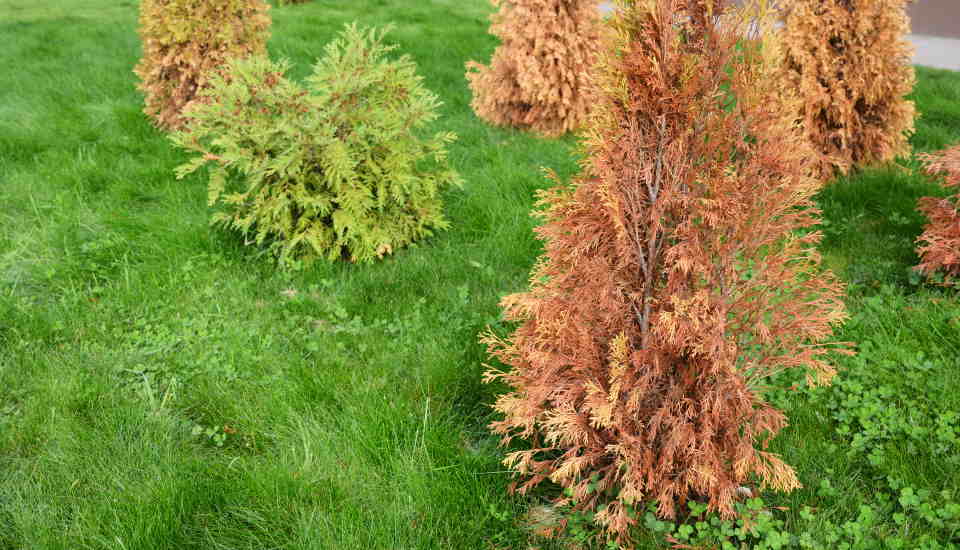
Your arborvitae tree can die for a variety of reasons. Arborvitae trees usually turn brown and die as a result of either over-saturated soil or a sudden drop in temperature. Another reason your tree may be dying is that it isn’t getting enough sunlight. Although each tree is unique, the arborvitae tree does not thrive in excessively cold or heavily shady conditions.
How to Save Brown Arborvitae Trees?
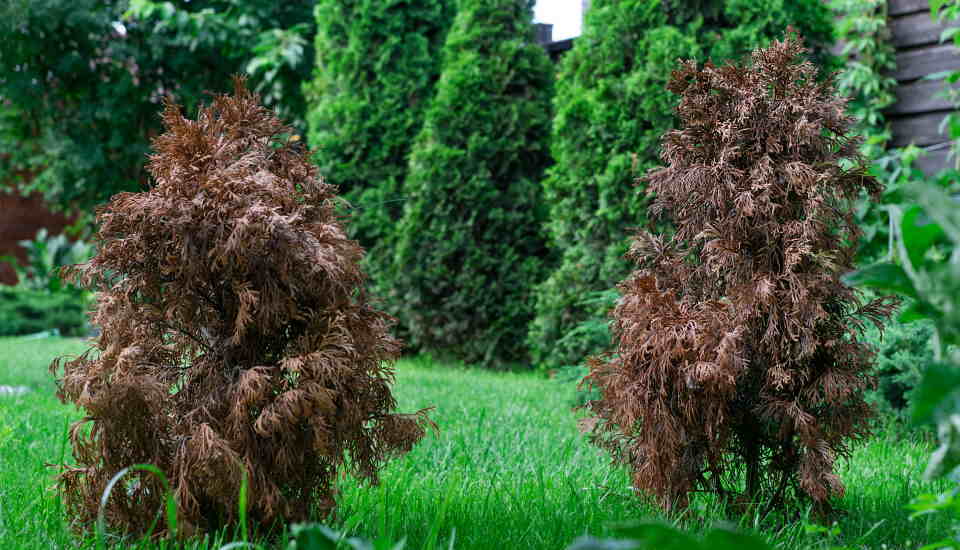
Timing is crucial when it comes to saving brown arborvitae trees. You usually only have a short period of time to fix your tree once it has become brown.
We discovered that placing new mulch around the base of the browning arborvitae tree slows the dying process and may even rescue the arborvitae tree. Another option to save your browning arborvitae tree is to clip it once new growth appears in the spring.
When to Plant Arborvitae Trees?
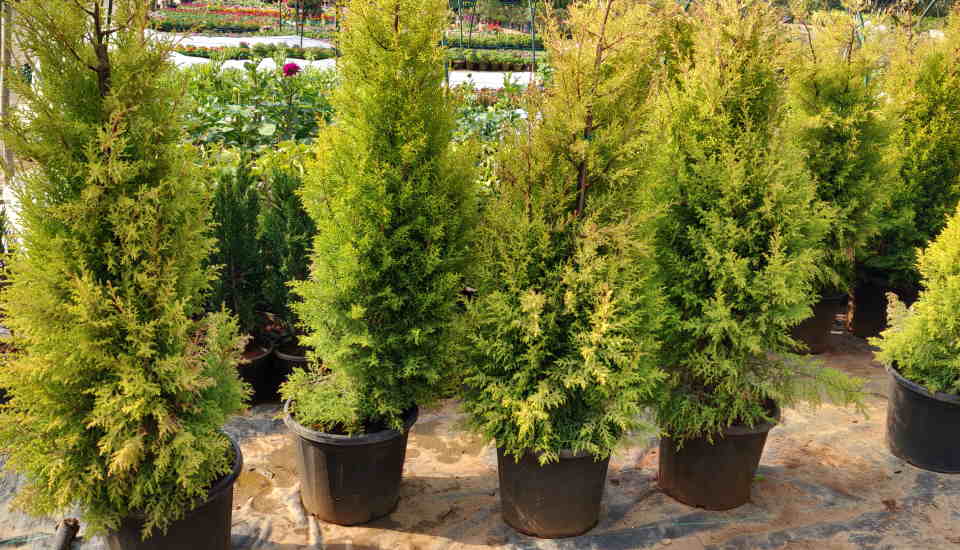
The answer is early April which is the best time to plant arborvitae trees. This allows the arborvitae tree to grow its roots and new growth before the winter arrives.
For optimal results, plant an arborvitae tree in the early spring. The best time to plant an arborvitae tree is early spring, when the earth has warmed and thawed sufficiently to operate with hand tools and accept the plant. Another incentive to plant arborvitae trees now is because they have not yet begun the majority of their growth for the year in early spring.
Some ask if planting arborvitae trees in the fall is a good idea. In some cases, planting arborvitae trees in the fall is acceptable.
The root will not be as well developed during the cold winter, but they will avoid the hottest summer months. If you live in the south, planting in the fall is a wonderful option, especially if you aren’t as diligent about watering. If you live in the north, planting arborvitae trees in the fall may not be as effective, but it is still possible.
How to Plant Arborvitae Trees?
It’s time to discuss how to plant arborvitae trees appropriately now that you know when to plant them.
- To make a fence, arborvitae trees closer together. When used arborvitaes to create a wall, they provide privacy.
- In the winter, arborvitae trees planted on the northern edge of your land will provide a windbreak.
- To create shaded regions in the summer, plant arborvitae trees on the west side of your land.
- Dig twice as deep and twice as broad as the container. Save the dirt for later.
- Arborvitae tree must be appropriately spaced. Consider how big they’ll be when you plant them, not how big they are now.
- Arborvitae tree is a container-grown plant. Therefore, arborvitae trees can be grown in a large container. However, it may require pruning to keep its size.
- Arborvitae trees require about 2-3 gallons of water each week, or about 1-2 inches of rainfall. So when you initially start, apply more.
- Slowly pour in a significant amount of water, then wait for it to soak in before adding more water—this aids in the root system’s penetration of the soil.
- More water should be added if the soil around the root ball is dry one inch below the surface.
Now we know how to plant arborvitae trees, and the next chapter is about where to find arborvitae trees for sale.
Arborvitae Trees for Sale
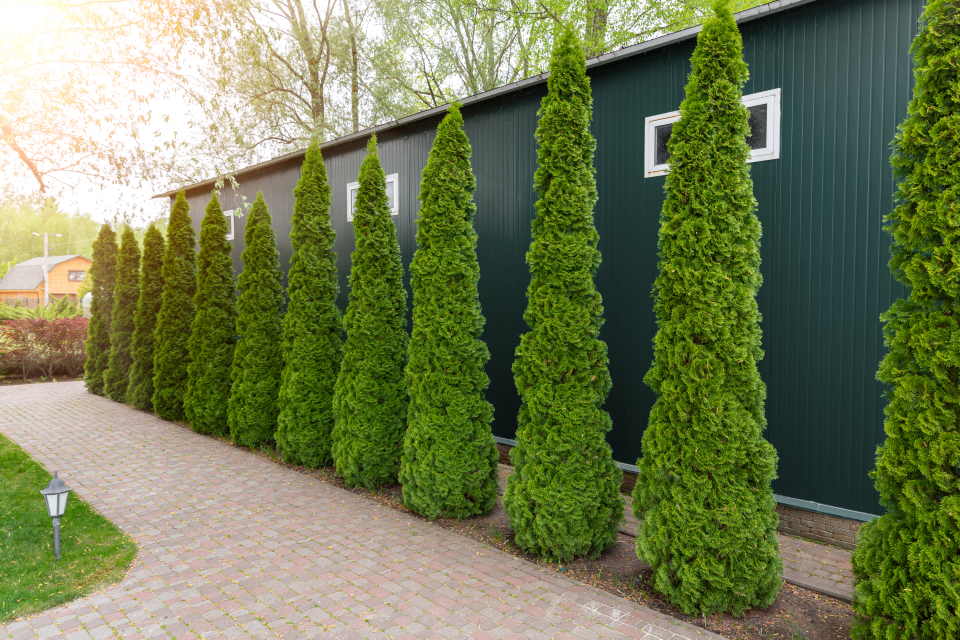
Arborvitae trees are simpler plants to grow since they are adaptable specimens that can withstand various temperatures. Whatever the case, the first step is determining which grow zone you reside in. Following that, a few additional things to consider as you plan to buy an Arborvitae tree for sale in your yard.
How Big Arborvitae Tree Becomes?
These trees are adaptable and respond well to regular pruning; what you want to develop and attain with your tree is entirely up to you as the gardener! Keep in mind that mature Arborvitae trees can reach a height of 60 feet and a width of 20 feet (and if left unpruned). If that’s the aesthetic you’re going for, make sure you pick a spot in your yard that can handle this kind of growth and expansion.
If you have a tiny room, don’t worry! As previously indicated, these trees respond well to pruning and can also be cultivated in pots as ornamental focus pieces in your garden or decorative items.
What Shape Do You Prefer?
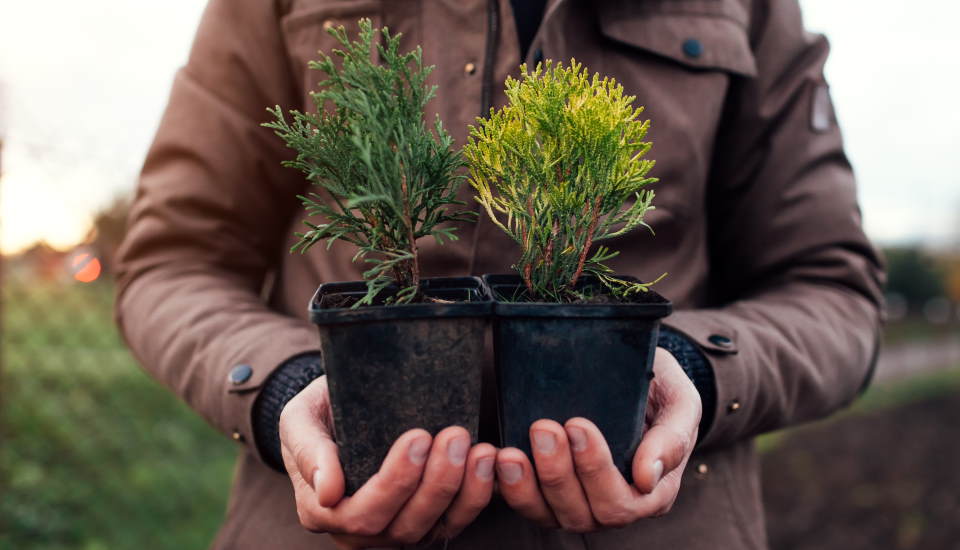
Arborvitae trees have a strong core trunk and a narrow upright habit, allowing them to grow tall and strong in any environment. These trees are extremely adaptable, and while they grow in similar cone-like patterns, the forms they produce vary greatly.
The American Pillar or DeGroot’s Spire will be a better fit if you want a plant that grows narrowly rather than widely. They provide great accents near entranceways and pathways. Check out the Forever Goldy, which is smaller and can be used as a hedge or shrub. The yellow coloring gives a wonderful and unusual touch to the dark green background, giving it more depth.
You can learn more about arborvitae trees from here:

